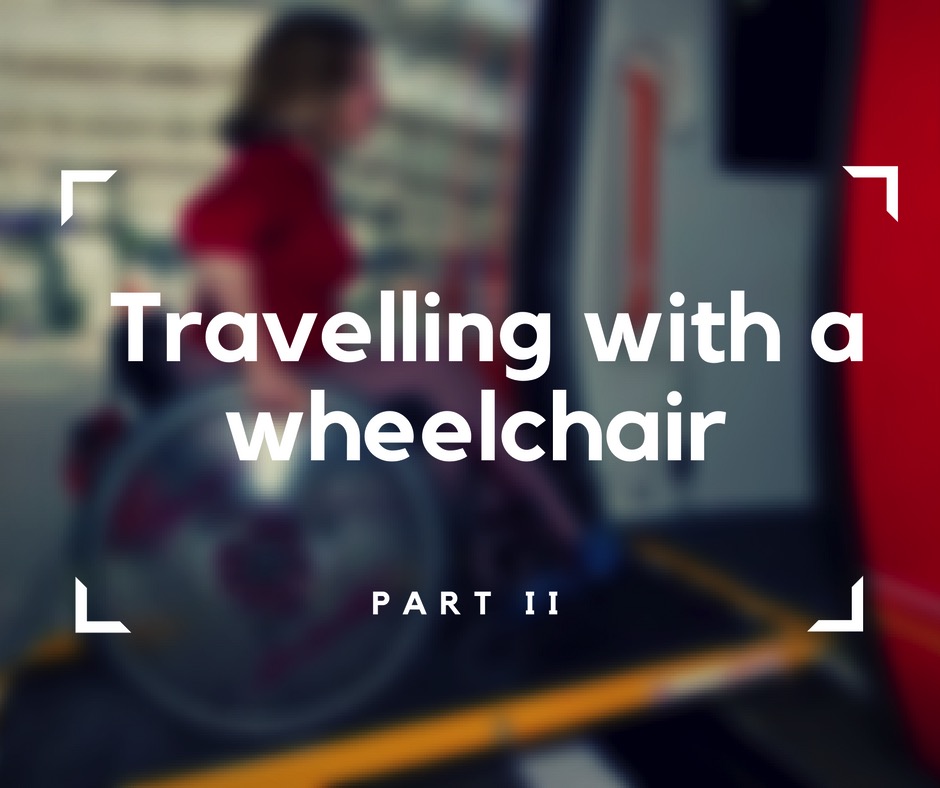Have you missed me? Well I hope you have. So, last time I presented you with the first part of a guide for travellers in which you could find some useful information on how to travel by car or by plane when you’re in a manual or electric wheelchair. Today, I would like to tell you a bit about trains, buses and taxis.

TRAINS AND MANUAL OR ELECTRIC WHEELCHAIR

The first thing you would probably like to know, is – can you travel by train with your electric wheelchair? The answer is: it depends on the train. I’ve come across super modern trains that could easily transport my Blumil electric wheelchair (which is really small) but they could also fit huge electric wheelchairs. And I have also come across trains from previous century and trust me – even a manual wheelchair was a huge problem. So if you plan to travel by train, it would be really good to pay a bit extra and travel in an adjusted train, than to pay less and not even get on a train at all.
How do you get your wheelchair on a train? Most trains are equipped with ramps, which can take a form of a lift or some sort of a footbridge. In America and most European countries the train staff is obliged to help you get on board BUT….of course, there has to be a but….if you travel internationally, while you’re buying your ticket, better let your carrier know that you will require assistance. I prefer to buy my tickets in person, but if that’s not possible for you then again – one call can solve many problems.
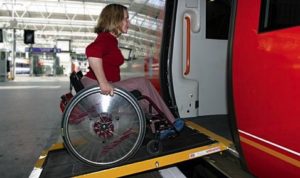
You may not know, but in many countries, for example in Poland, there is a special discount for the disabled and their assistants. Normally you should be informed about it when buying tickets, but sometimes….let’s just say it’s good to know your rights So read a little about train discounts (all info should be on the operator’s website), you will not save millions but will buy yourself some ice cream. That’s something!
All right, but you’re probably wondering: where will I be seating? You’ll be either seating in your wheelchair or, in case train has adjusted seats, you will be transferred into special train seats, which are a bit wider than the regular ones, so it’s easy for the disabled to get onto them. What happens to your wheelchair then? Well it really depends on the train design. Sometimes you may keep your wheelchair next to you in the corridor, but sometimes, if there’s no space, train staff will be forced to either fold or move your wheelchair where it doesn’t violate the safety rules.
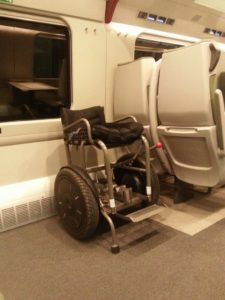
Next standard case: toilets. Most trains have adjusted restrooms, big enough to accommodate even a person with an electric wheelchair (the Blumil has no problem with that, but sometimes big power chairs and electric wheelchairs don’t have enough room) . The toilets are usually in the same car where adjusted seats are, so you won’t have to walk through the whole train).
BUSES, TAXIS, SUBWAYS
BUS AND MANUAL OR ELECTRIC WHEELCHAIR
If you want to travel by bus you have to be aware that in some countries there is a law that says that only one wheeled device may be aboard during fare. So for example in UK you may be forced to let a couple of buses go, because there will be a lot other people in wheelchairs or mothers with children in strollers. The reason for that law is that there is only one adjusted area and it fits only one device. Fortunately in Poland such law doesn’t exist but of course it’s for your own safety that you shouldn’t be squeezing into a crowded bus when the adjusted area is taken by someone else.
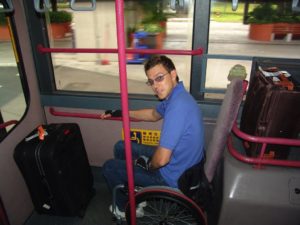
How to get into the bus? Same thing as with trains – each bus has a special ramp that appears on demand after you click a button located near the bus door. Sometimes, if you have trouble with getting in, the driver will help you, but it’s only in extreme cases as it may be dangerous for every passenger when the wheel is unattended.
Pro tip: You may also be entitled to a discount, so check, check, check
TAXI AND WHEELCHAIR
If you’re lucky to live or travel to London then you probably should know that all taxis are adjusted as a standard! Nowadays, almost every company offers adjusted taxis on demand – but it’s important that you let them know that you’ll be needing one (unfortunately, big electric wheelchair won’t fit). If you don’t make a request for an adjusted taxi then…well…. I have encountered so many taxi drivers who refused to provide me with their service. Some of them had problems with me being in a wheelchair, some had problems with folding my wheelchair and some had no apparent reason to be angry, but still managed to be.
Fortunately, the competition in the taxi business is growing so the companies are really trying hard to satisfy every client. If you want to avoid such situations, listen to my advice: Let the taxi company know that you will need help with your wheelchair. They will know how to handle it. And if a taxi driver refuses to give you a lift, report it to his company – we can not let anyone discriminate us!

SUBWAY AND WHEELCHAIR
The fastest way to get from one to another side of the city is subway. I really like it as it is fast and comfortable. It’s true – the adjusted areas are only in both last cars, but I have never encountered any problems with lack of space. In Poland we have a very modern subway, so the trains are very low and the Blumil can get inside without the ramp, but if you need one, there should always be a button located somewhere near the door. Usually, there is always someone from the subway staff on platforms so if you have any problems, they will help you.
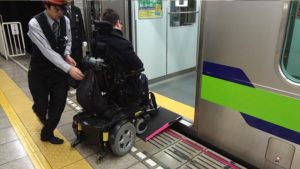
One more thing – sometimes finding an elevator may be tricky, but it’s usually located at the both ends of the platform.

Guys, if you feel like I should give you more info, let me know in the comment section. I really hope I clearly explained some things. And I really, really hope this post will encourage someone to travel!

